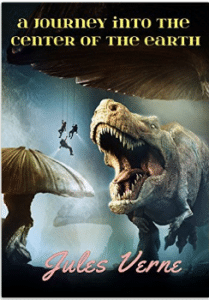 The Beauty of Winding, Subterranean Galleries
The Beauty of Winding, Subterranean Galleries
Author: Jules Verne
In the classic library mode yet again, I decided to go back to one of my childhood favorites: Jules Verne. Mesmerized by his Around the World in Eighty Days in grade school and later enthralled by the mystery of Captain Nemo in 20,000 Leagues Under the Sea, I was excited to once again return to a beloved author. The sense of adventure and the vivacity of a pioneering spirit soars in Verne’s work, especially in Journey to the Center of the Earth where three vastly different characters confront natural and man-made obstacles. We have Axel, the terrified student who loathes adventure and even more so, possible risk, pitted against his venerable and impulsive uncle, Professor Lidenbrock who has accidentally stumbled upon an ancient manuscript that inspires his incredible journey. The fear of Axel promotes an early tension in the work and a seeping paranoia while the hilarity of the uncle provides both amusement and foreshadowing. Undeterred, the Professor drags his nephew to the foot of Mount Snæfellsjökull (aka Sneffels), a supposedly extinct volcano. According to the found manuscript, volcanic tunnels lead to the center of the earth and make the journey possible, the entrance being via this far flung volcano in the heart of Iceland. Along for the adventure is the imperturbable eiderdown hunter and their temporary guide.
The novel has an oddly airy sense to it, a light bouncy cheeriness that isn’t present in say, 20,000 Leagues. The Professor is a different type of Jules Verne character. He’s scientific and knowledgeable yes, but more defined by his child like exuberance and impulsiveness, giving the character’s perspicacity the charming aura of sheer enthusiasm. Readers will find themselves getting excited about the different levels of rock, the shining geodes, the echoing galleries, and all that lies in between both from the eyes of a traveler and a keen scientist. If only geology had been this interesting when I was in school . . . .
There are strata of the story, starting with the simple, yet oddly claustrophobic tunnels, the sharp rasp of volcanic rock and the aloneness of the underground, transforming and becoming more alien with descent, sharp descent that is. Deep chasms and hours spent working short ropes and grabbing toe holds in gapping voids mark the journey more than the occasional respite of a tunnel. The stark subterranean beauty is oddly mesmerizing, and while listening to the novel my mind drifted away from the long stretches of interstate between me and home, and roamed quiet caverns, both terrifying and yet, so surreal as to be appealing. A place you fear to get lost in, but want to roam anyway. The effect is dreamy, and without much effort the readers are pacing alongside the professor and his unwilling student because come what may, damn the danger, we want in on this. We need this too. I can’t explain how, or why, or what literary form Verne is employing so well, only its impact on me and my sudden understanding that there can be beauty, even under all the dark earth and along chambers of lava and old fires long gone out.
But winding tunnels and stalactites aren’t all you’re going to find as you venture down into the darkness. As the characters progress, pre-historic skeletons and bones litter there way until the travel to a vast Central Sea where giant fungi and strange forests populate a primordial land trapped in an ageless abyss, completing the otherworldly sense of adventure on our own planet.
As a reader, I have to admit that this novel made me contemplate all the still hidden mysteries of our own planet, all the undiscovered creatures deep in the ocean’s crevices for instance. Journey to the Center of the Earth awakened a wondering that had long since left me and made me look at the world around me in a fresher manner. What discoveries are still out there? What adventures? What tales are waiting to be created and passed down through the ages?
Not that the novel was perfect in my estimation, however. It does grieve me to even think of critiquing Verne, yet, the seemingly senseless act in the conclusion and what must have been a wide ranging ecological destruction isn’t even addressed at the conclusion, the characters having escaped without ever thinking of the havoc they caused in a world that remained peaceful for thousands of years. It’s the elephant in the room, and while the conclusion merrily advances around it, readers wonder why our conscientious and science minded cast, all who would seek preservation of such a rare discovery, don’t even seem to ponder the thought of what is now below their feet.
The unabridged edition I listened to was read by Stephan Cox and promoted an already pleasurable reading extravaganza. I actually wished for long traffic jams just so that I could spend more time in this world which Cox fully brought alive. The fear of the student and the exacerbating doggedness of the Professor are brought to life as is the Icelandic language and the thrilling names of so many geographical specimens. A true immersion experience, the audio version is the best way to approach this journey. Highly recommended.
- Frances Carden


My wife and I, after reading 1984, Brave New World, and Farenheit 451, decided we needed a good old classic rousing fantasy adventure, so we are now on chapter 12 in “Journey.” We plan to watch the movie based on this novel with James Mason and Pat Boone afterward. Then, onward through 20,000 Leagues and Mysterious Island!